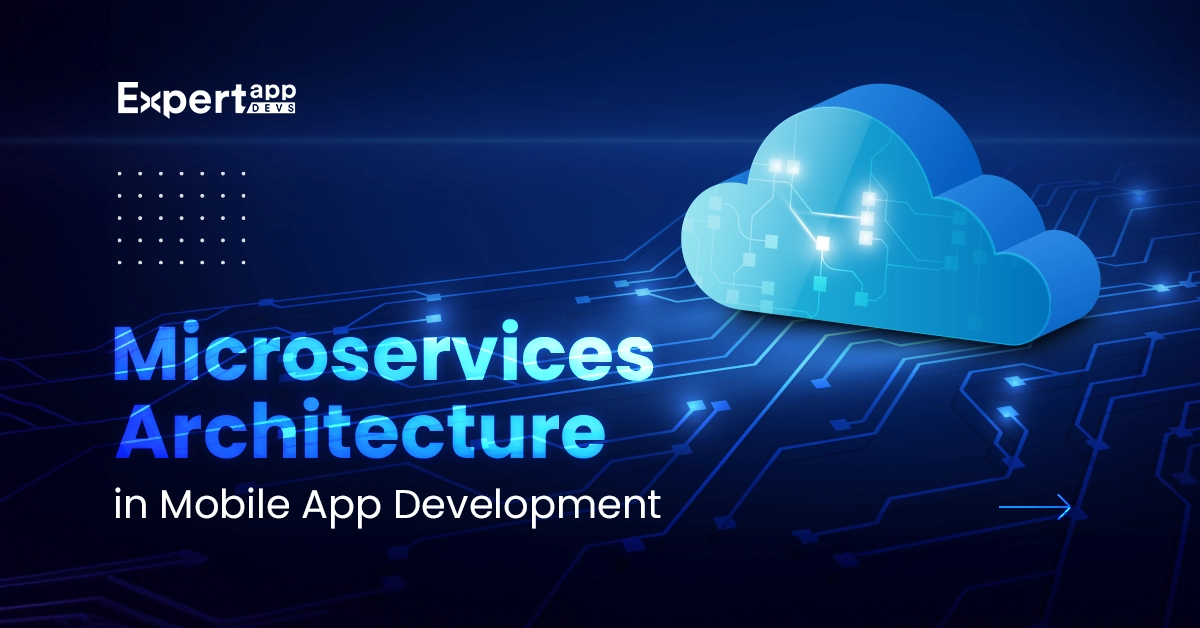The Role of Microservices Architecture in Mobile App Development
Ever wondered what users expect from a mobile app development business? Your user would prefer a fast-performing and high-quality application that exceeds their experience expectations. Additionally, they would love it if your website doesn’t crash too often.
The design elements, codebase and testing are pivotal to ensure high-quality solutions. However, the most crucial aspect of performance optimization is the architecture. A well-structured skeleton can help you plan your experience design and encourage quality.
Microservices architecture has been gaining a lot of attention in recent times. Several businesses have bolstered their online reputation and mastered performance with this architecture.
This architecture breaks down app development into smaller chunks that shorten the development cycles. Each of these apps extends an independent business service that fosters organic growth.
You can use this architecture to simplify workflows and build a profitable business. This article will explore the microservices architecture in-depth to understand its pros, cons and use cases.
What is Microservices Architecture?
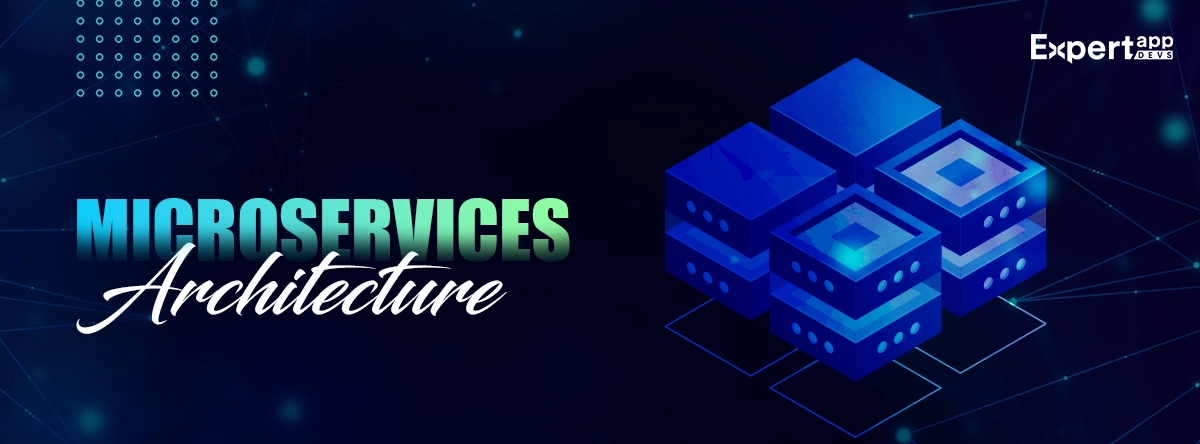
Microservices architecture looks at the mobile application as a series of small and independent solutions. These independent solutions can solve a particular problem and become an extension of the business service. Moreover, these independent services can be coupled into a single system or enjoyed independently by the user.
This software development approach allows businesses to release their apps faster into the market. It helps the business offer its services in a more manageable and approachable manner to the user.
How Microservices Architecture Works?
The Microservices architecture undergoes a proper process, where each part of the process looks into specifics.
- Decomposition- This is the part where a large monolithic application is broken down into several small services. As they are self-contained, your users can use it as an independent application that serves a particular business function.
- You can use APIs to enable communication between these different services or systems. These services can also be used independently by the users or businesses.
- You can also use different programming languages or frameworks to build these services as they are developed and scaled independently of the others.
- The geographical boundaries are blurred in microservices. You can use servers and data centres across geographies for better access and zero downtime.
- Lastly, it promotes agile development as teams work on separate development or services.
The perfect example of a microservices architecture occurs when you consider an eCommerce solution. Microservices architecture builds separate eCommerce solutions for services like user management, product catalogue, order processing and payments.
These can be developed and scaled independently. At the same time, you can integrate them into a single app structure.
Top Benefits of Microservices Architecture
- You can scale a particular system or service independently without impacting the other solutions.
- It extends the flexibility to use different tech stacks and tools to build individual services for your business app.
- As the teams are spread out to work on independent solutions, you can shorten development cycles. It also promotes agility, which encourages fast releases for your business.
- Each service has a separate codebase. It is easier to maintain and update the smaller codebases, reducing resource efforts.
- You can identify the faults or issues within the systems owing to the independent systems. It is easier to isolate the bugs and address them with this architecture.
- Your teams can work independently and collaboratively with this architecture.
- It promotes continuous integration and deployment services for quick and fault-free app development.
How to Implement Microservices Architecture?
You must think through the different aspects of mobile app development when considering employing microservices architecture. Here are all the portions that will contribute towards a defined mobile application.
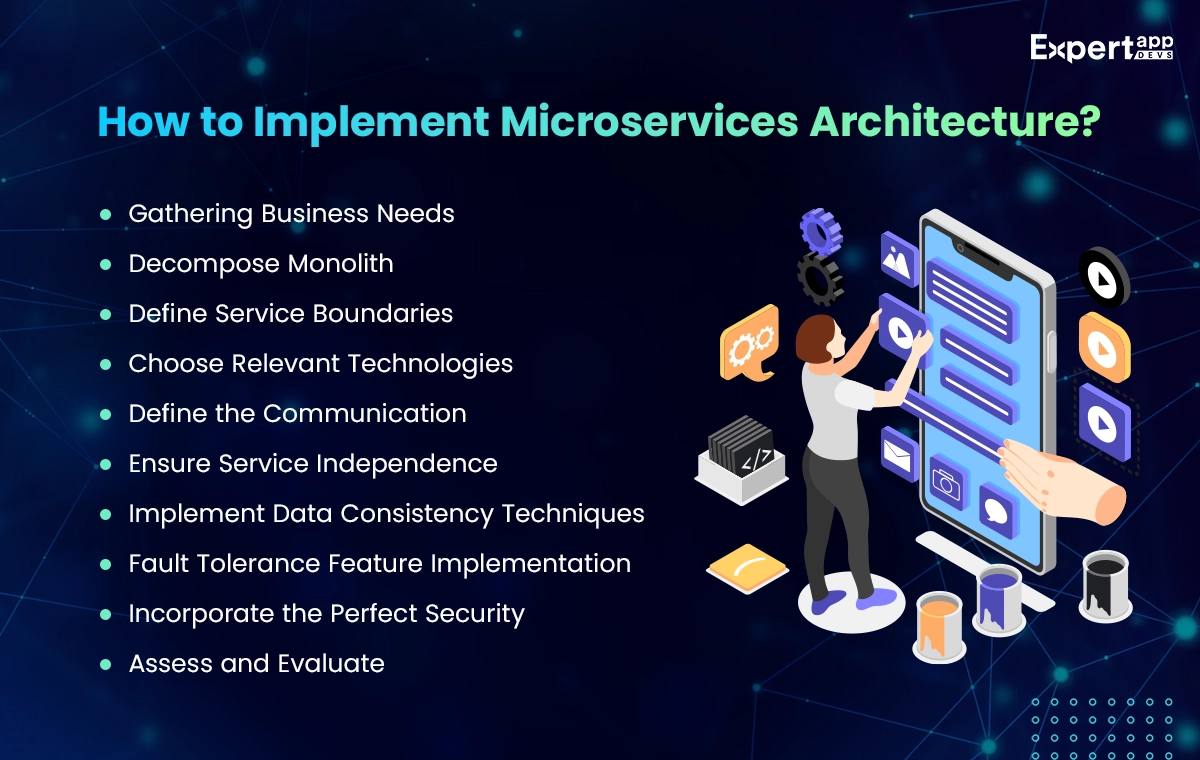
#1 Gathering Business Needs
You cannot embark on a mobile app development journey without knowing what you need to build. Your scope is defined by what your business and the customers need. You must start your job by defining the requirements, purpose and goals of the mobile application.
If you can find a singular functionality or USP defining business capabilities, outline it in your document. The document should also comprise the various features that you wish to extend to your users.
#2 Decompose Monolith
You must evaluate the existing monolith application that exists for your business. Try and break it down into multiple small and manageable components or services. It would help plan the entire application development better.
You must consider the segments of the application that can function as a silo. Take note of these services while identifying how to merge or combine these systems.
#3 Define Service Boundaries
Each service or application should fulfill a defined responsibility. It is crucial to be clear about the scope from the start. You can also determine the boundaries for the scope.
This will ensure that the microservice architecture is defined and clear. It will also help you build a more niche-focused solution that guarantees attention.
#4 Choose Relevant Technologies
Based on the defined scope you can begin determining the technologies or frameworks to develop the mobile apps. It should fit your requirements and further your vision. You can use factors such as ease of deployment and scalability to determine the technology.
Additionally, you can also consider the performance of the tool to assess its ability to develop your business application.
#5 Define the Communication
The communication protocols are crucial for microservices to work seamlessly. You must determine how the APIs will communicate with the microservices. Similarly, you must also determine how to imagine a seamless database communication.
You can use RESTful APIs and message queues to drive perfect communication. You can also incorporate event-driven architectures for the best results.
#6 Ensure Service Independence
You must ensure service independence between the two microservices applications you build. Including a separate database for each of these microservices applications is crucial.
When you ensure a separate database for each service, they will not depend on the internal state of these services.
#7 Implement Data Consistency Techniques
You might face challenges related to data consistency when planning your microservices applications. This can lead to inconsistencies within the applications. You can implement strategies like eventual consistency or distributed transactions to maintain consistency.
#8 Fault Tolerance Feature Implementation
You must design your microservices application to be resilient to failures. You can implement techniques such as circuit breakers or fallback mechanisms for the perfect solutions.
These will prepare your application for fault tolerance and ensure redundancy.
#9 Incorporate the Perfect Security
Each microservice should be treated as an individual application. This can help you plan the security protocols and authentication systems for your business application.
You can use this protocol to define your authorization and plan the communication channels.
#10 Assess and Evaluate
Testing the microservices application is crucial for a bug-free deployment. You can conduct detailed unit, integration and functionality tests for the best outcomes.
You can also consider using these protocols to evaluate the system's resilience.
Best Practices for Microservices Architecture
Incorporating the best practices while implementing the microservices architecture is crucial for seamless development and deployment.
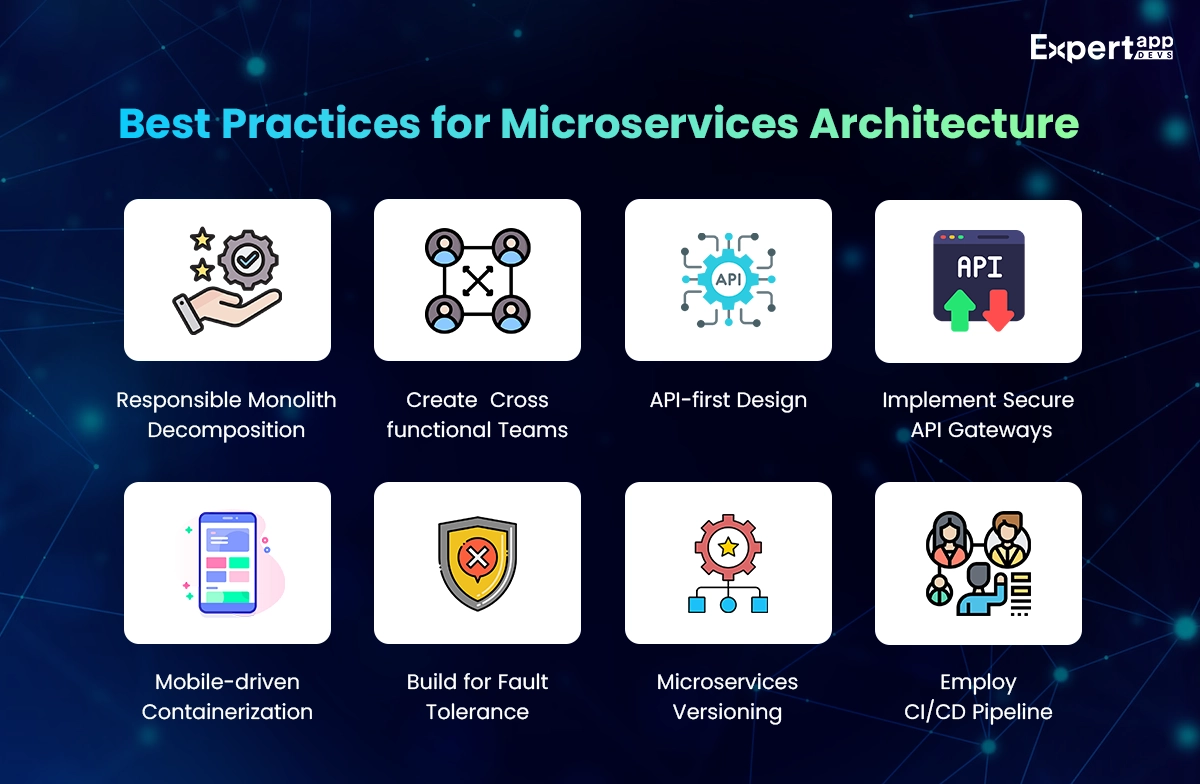
#1 Responsible Monolith Decomposition
When you plan the microservices application, you must break down the monolith solution. This should be done responsibly. You must ensure the functionality is safe. It is equally important to build a modular and maintainable architecture.
For a responsible decomposition, you can clearly define the scope and boundary of the application.
#2 Create Cross-functional Teams
You should always focus on the business capabilities with microservices architecture. Your micro applications will cater to specific requirements or needs. that’s why you must build teams that are strong in the particular segment and can work independently.
Accountability and ownership can enable them towards better decisions and smooth app development.
#3 API-first Design
You must take the API-first route to build your microservices application. This will help you plan for the APIs and ensure consistency within the application. Additionally, you can simplify and streamline the integration processes and reuse the inherent components.
#4 Implement Secure API Gateways
Security is crucial when you integrate your microservices application with third-party tools or products. That’s why you must pave the way for managed and controlled API access. Make sure to include a centralized entry to manage authorizations and traffic encryption.
You can also use a unified interface for better engagement and defined user movements.
#5 Mobile-driven Containerization
Your containerization strategies must include mobile users. From bandwidth restrictions to resource issues, you must plan for all the possibilities. You can implement lightweight containers for efficient data transfer and best performances.
#6 Build for Fault Tolerance
You must create mobile apps that are built to tolerate failures and issues. You can use strategies such as circuit breakers and fallback mechanisms to handle the faults easily. You can deliver a more functional and stable microservices application with this implementation.
#7 Microservices Versioning
You can use the versioning tools to ensure backward compatibility within the applications. It can also enable smooth and effective transitions. Moreover, it ensures frequent updates needed by your system. You must specify the policies for versioning.
#8 Employ CI/CD Pipeline
Using CI/CD pipelines, you can automate the build-to-deploy processes. This helps shorten development cycles and reduce errors. At the same time, you can effectively launch new features and updates at a designated frequency to your microservices solution.
Tools and Top App Examples
You must use the right tools and technologies to improve the microservices architecture. It can also help optimize your solutions.
Let’s explore the tool landscape for microservices. You can also learn how top companies have leveraged this architecture to streamline their businesses.
Top Tools for Microservices Architecture
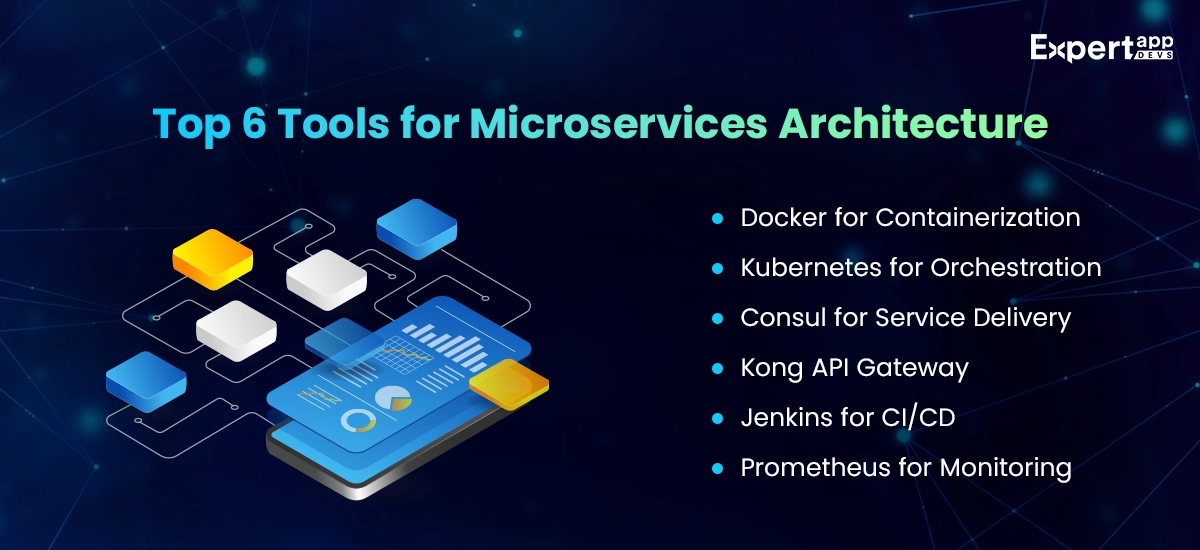
#1. Docker for Containerization
Docker helps you simplify the packaging and deploying processes while developing an application. You can package them into lightweight and portable containers. You can use this tool to build scalable and consistent applications that can be used across various environments.
#2. Kubernetes for Orchestration
This is the perfect tool for orchestration. It automates the deployment, management and scaling of your containerized applications. it comes with load balancing, self-healing and service discovery features that enable orchestration.
#3. Consul for Service Delivery
It is a service mesh solution that enhances audit opportunities and dynamic configuration of the microservices. It can also aid in service delivery. Using this tool, you can ensure seamlessness between the diverse services. It also helps enhance the reliability of these services.
#4. Kong API Gateway
This open-source API gateway ensures streamlined management and fully secure APIs. The tool will help centralize the user’s entry point to ensure proper authentication and authorisation. Moreover, you can leverage features like rate limiting and logging for better performance.
#5. Jenkins for CI/CD
This CI/CD tool automates the various aspects of app development and deployment. This automation promotes efficient development teams with streamlined operations and defined processes.
#6. Prometheus for Monitoring
It is an excellent monitoring and alerting toolkit that helps fix bugs and mitigate risks for your microservices solution. It can help collect and store the different metrics. This tool can also ensure real-time analysis and quick visualization of your app’s health.
Top App Examples of Microservices Architecture
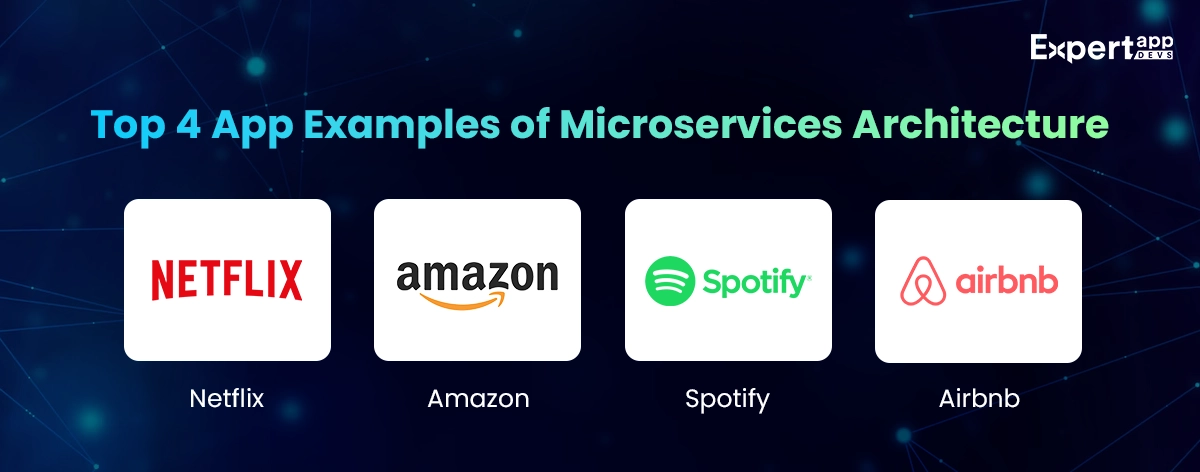
#1. Netflix
Netflix, the popular streaming platform, has successfully implemented the microservices architecture. They have built their entire platform using multiple microservices that are resilient and scalable. This has helped them launch new features and improve the solution.
#2. Amazon
Amazon Web Services (AWS) has defined several microservices that can help enhance modern cloud computing solutions. They have built several reliable and scalable cloud-based services.
#3. Spotify
This music streaming service has used this architecture to facilitate prompt updates and personalize the recommendations. It has also reinvented user interactions to foster positive experiences.
#4. Airbnb
They have implemented the microservices architecture to power their property rentals platform. It has helped them scale the business to meet the new demands. Additionally, they have been able to incorporate fault tolerance with this architecture.
Monolithic vs Microservices Architecture
You must be aware of the major differences between a monolithic and microservices architecture to make the right choice. We will consider the top five factors to understand the difference.
#1 Definition
- When an application is developed as a single and integrated unit, it is a monolithic architecture. The user interface, logic and data access layers are tightly integrated into this application.
- Microservices architecture tends to break down the entire application into small and independent services. Each service is responsible for a specific aspect of the business. You can use APIs to connect the services and integrate the systems.
#2 Development and Deployment
- In monolithic architecture, developers work with a single codebase and employ the unified deployment method. After changing a small portion of the application, the developers need to deploy the entire application. It uses a systematic development approach. However, the development process is slower.
- Each service is developed and deployed independently with Microservices architecture. Each service has individual codebases and logic. You can roll out updates and add features to these independent applications. It ensures greater flexibility. However, you need to manage the interdependencies carefully for the best outcomes.
#3 Scalability
- You must replicate the entire application to scale your monolith solution. This can be a resource-intensive and time-consuming affair. Moreover, you need to scale the budget and resources according to the complexity of the update or feature addition.
- You can foster granular scalability by implementing microservices architecture. Each service can be scaled independently and as per the business need. It helps manage the resources available. Moreover, your resources can ensure optimal resource utilization to fulfill the job.
#4 Maintenance
- It is easier to maintain a monolith application owing to the single codebase. But, as you add more features and upgrades, your app grows complex. Handling the complex workflow and maintaining the app can be slightly challenging
- Microservices architecture is distributed. As a result, you must maintain an individual codebase. This is easier to handle. However, you must employ the best versioning and communication protocols to coordinate these changes.
#5 Fault Tolerance
- If a component or unit of the monolith application fails, it can lead to an app failure. The app becomes unavailable to the users. You must ensure proper redundancy and failover mechanisms for fault tolerance. This must be applicable throughout the application
- The microservices architecture is inherently fault tolerant. If one service fails, the others remain unaffected. You need to apply redundancy or resilience for the particular service only.
How to Make the Right Choice?
It is indeed a challenge to choose between the monolithic and microservices architecture. Here are a few factors to consider before making the right decision.
- If you are working on small-scale projects, you can opt for monolithic architecture. It is best for solutions that don’t need scaling or large-scale maintenance. You can choose microservices for scalable and large-size projects that delve into complexities.
- Monolithic architecture is best suited if you have a team that is well-versed in traditional development. They may not understand the nuances of distributed systems and cannot offer the solution. however, if you have a team that can build, manage and maintain distributed systems, go with microservices architecture. They should be adept with containerization and orchestration.
- Monolithic architecture is suited when you need consistency throughout the application. You can use the architecture when you need a predictable application scaling. Microservices architecture fits your needs when you have diverse scalability needs. Moreover, it is a great asset when you have limited scaling and distributed scaling aspects.
- If your project poses stable and defined requirements, you can go with a monolithic architecture. However, if you need to update your application frequently, you might want to choose microservices. It can help with agile development and independent service deployment.
- If you have developed a resource-intensive solution and looking for optimal resource utilisation, go with monolith. It can reduce resource overheads as you don’t need to manage multiple unique services. Microservices are resource-optimized and can handle fluctuating resource demands. You can easily use this architecture for best resource allocation.
Microservices vs Serverless Architecture
Serverless architecture is a new and emerging trend. You must know how it differs from microservices.
Microservices Architecture
- Microservices architecture is when you develop an application as a collection of services that are independent and loosely integrated.
- Each service operates independently. This ensures autonomy in development-to-scaling cycles.
- This architecture supports continuous deployment, which leads to short release cycles and agile development.
- Each service is independently scaled to meet the optimization and resource utilization needs.
- Microservices are flexible and adaptable. However, they need complex orchestration to manage the distribution.
Serverless Architecture
- Function-as-a-service architecture allows you to write the functions without managing the infrastructure.
- The functions are event-triggered in serverless. Specific requests or events can lead to a particular function. This leads to resource optimization.
- You can scale the functions to meet the workload fluctuations with serverless.
- As developers don’t need to maintain or manage the servers, they can focus on coding jobs. This improves the efficiency.
- This architecture might cause latency as the resource initialization occurs only when a function is requested. This is particularly true after a short period of inactivity.
Cost of Microservices Architecture in App Development
The cost of developing mobile apps with microservices architecture varies for different businesses and app types. Here are a few factors that will impact the cost of development mobile microservices.
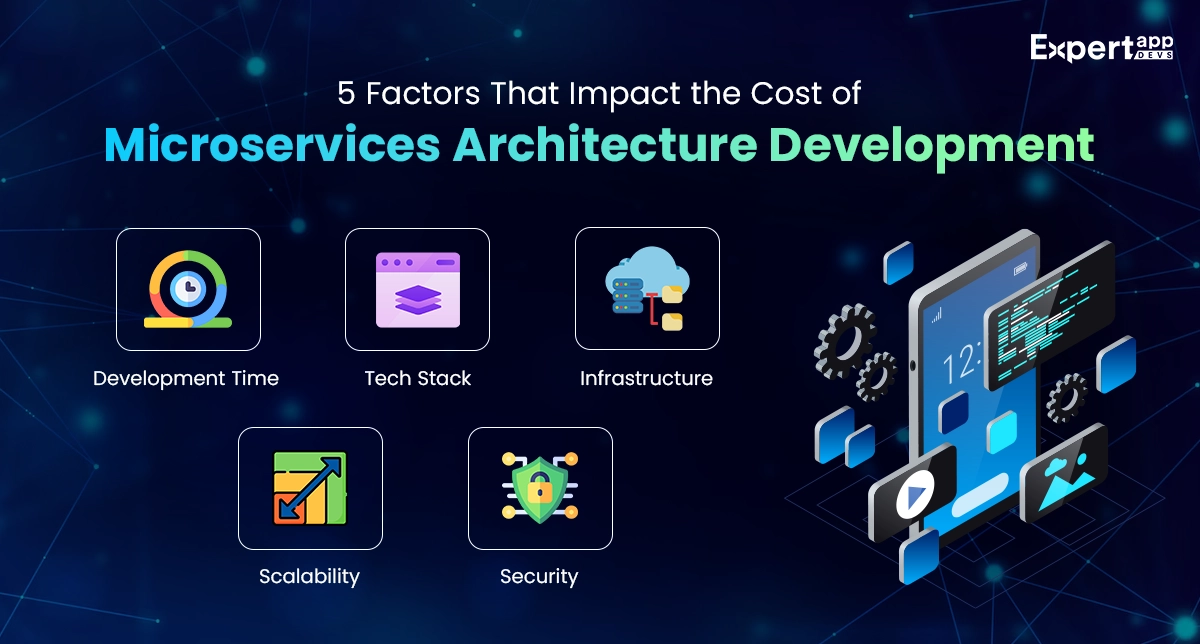
#1. Development Time
This is a direct outcome of the complexities involved with app development. You might need resources and time to develop complex services with advanced features.
#2. Tech Stack
The tools, frameworks and licenses needed to build, test, deploy, maintain and scale your services are pivotal in determining the cost.
#3. Infrastructure
You need sophisticated tools and technologies (containerization and orchestration tools included) to develop your services. These can add to your app development budget.
#4. Scalability
If you want a scalable and dynamic service, you must implement the relevant strategies. This can also contribute to the cost of development.
#5. Security
Robust security and authentication methods need prominent tools and expert resources. You might need to spend on ensuring a secure and safe service platform.
Apart from these, you must plan for training and other expenses while planning the budget for microservices in mobile app development.
Future Trends
It is equally important to know the microservices future trends. This will help you plan the architecture in tandem with the emerging requirements.
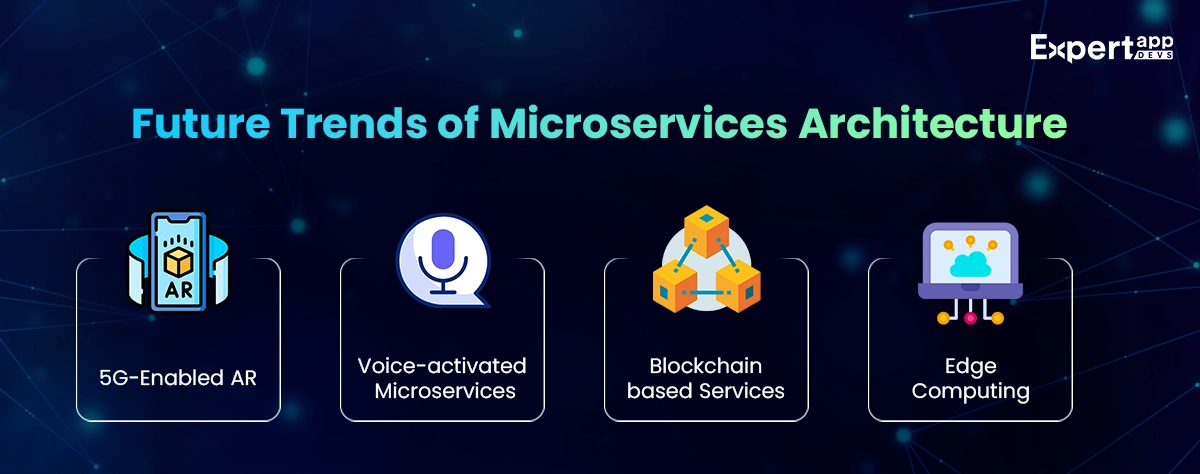
#1 5G-Enabled AR
Microservices can harness the potential of Augmented Reality to improve real-time interactions and data processing. When you combine this with a 5G network, you get high-speed and low-latency services that extend immersive experiences.
If your navigation apps are built using 5G and AR technologies, they can offer real-time and relevant information. It will reduce the latency and power you with accurate information.
#2 Voice-activated Microservices
The advent of voice-based interfaces and virtual assistants is integral to excellent experiences. Your microservices must be built for voice recognition and NLP. It can help improve the user’s experience and enable them for seamless communicate seamlessly with mobile apps.
Your user can interact with the mobile applications via this architecture without using their hands or gestures. This can improve their on-the-move interactions.
#3 Blockchain-based Services
Blockchain-enabled microservices can enhance the security and transparency within transactions. You can use this trend to foster secure data sharing. Mobile apps that use Blockchain-powered microservices can extend secure and decentralized transactions.
#4 Edge Computing
When you deploy the app on the edge, your users are closer to the computing resources. This helps acquire the data in real-time. It reduces the latency that can impact the experience. It is a perfect asset for mobile gaming apps. It can boost immersive experiences in multi-player solutions.
The Flipside of Microservices
While microservices are a great asset to your project, there are limitations to this architecture.
#1. Increased complexity
Modularity is a boon and a curse. Modularity can help you improve the development but, it can also lead to complex development.
If you are not clear about the modularity, you can end up having coordination and dependency issues. Distributed services can also increase the complexities within the architecture.
Development teams may need help to troubleshoot these issues and mitigate them. It can also hamper the compatibility between the services.
#2. Overhead
Microservices can lead to operational overheads. Each of the services in the distributed structure requires an infrastructure, monitoring solutions and a pipeline to continuously deploy the apps. You need to invest in separate containerization and service discovery tools for the individual services.
You may use more resources that add to your costs. You must also spend on the infrastructure to deliver a microservice.
#3. Debugging
As the microservices architecture involves multiple services, you need to debug these individually. It can add difficulties in determining the root cause and addressing the issue. Moreover, you may find the whole process time-consuming and complex.
Conclusion
Microservices architecture can help large businesses distribute their services and ensure smooth deployments. it extends agility and flexibility to small and large enterprises. You can build mission-critical and high-performing applications easily with this architecture.
While there are benefits to taking this approach, you might experience debugging issues and operational overhead. You can unleash immersive experiences by blending microservices architecture with new-age technologies and trends.
Expert App Devs are adept with new-age techniques, tools and infrastructure. We can help craft immersive microservices architecture-based solutions for your business. Connect with us to explore the possibilities in this realm. Hire microservices development company from India.
 Jignen Pandya
Jignen Pandya
